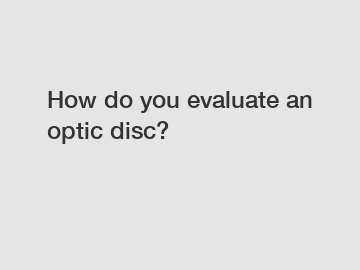Mar. 25, 2024
weiqing supply professional and honest service.
Have you ever wondered how eye doctors evaluate the optic disc during an eye exam? The optic disc, also known as the optic nerve head, is the area where the optic nerve enters the eye and is crucial for maintaining good vision. Let's dive into how optometrists and ophthalmologists evaluate this important part of the eye.
What is the Optic Disc?

The optic disc is located at the back of the eye and is where the optic nerve connects to the retina. It is responsible for transmitting visual information from the eye to the brain. During an eye exam, evaluating the optic disc can provide important information about a person's eye health and any potential eye conditions they may have.
1. Appearance and Color.
When evaluating the optic disc, eye care professionals look at its appearance and color. A healthy optic disc should have a pale pink or orange color and a distinct border. Any changes in color or irregularities in the border could indicate underlying eye conditions such as glaucoma or optic neuritis.
2. Size and Shape.
The size and shape of the optic disc are also important factors to consider during evaluation. A normal optic disc should be round or oval in shape and have a size that is within the expected range. Any abnormalities in size or shape could be a sign of optic nerve damage or other eye diseases.
3. Cup-to-Disc Ratio.
One of the key measurements used to evaluate the optic disc is the cup-to-disc ratio. This ratio compares the size of the optic cup (the central depression in the optic disc) to the size of the optic disc itself. A larger cup-to-disc ratio could indicate glaucoma, a condition that causes damage to the optic nerve and can lead to vision loss if left untreated.
4. Optic Disc Edema.
Optic disc edema is a condition in which the optic disc becomes swollen due to increased intracranial pressure or other underlying health issues. Eye care professionals will look for signs of optic disc edema during an eye exam, such as blurred margins or disc hemorrhages. This condition requires prompt medical attention to prevent further vision damage.
5. Imaging Tests.
In addition to a visual examination, eye doctors may also use imaging tests such as optical coherence tomography (OCT) or fundus photography to evaluate the optic disc in more detail. These tests can provide high-resolution images of the optic disc and help detect any subtle changes that may not be visible through a regular eye exam.
Overall, evaluating the optic disc is an important part of an eye exam as it can provide valuable information about a person's eye health and any potential eye conditions they may have. If you have concerns about your optic disc or are experiencing vision changes, contact us to schedule an eye exam with a qualified eye care professional who can assess your eye health and provide the necessary treatment. Remember, regular eye exams are essential for maintaining good vision and overall eye health. Partnering with a reliable supplier of eye care products is also important for keeping your eyes in optimal condition. .
So, if you want to ensure your eyes are in good hands, contact us today to book your next eye exam and get the eye care products you need. Your vision is important, so don't wait – schedule an appointment with us today.
You can find more information on our web, so please take a look.
Want more information on Indocyanine Green Angiography? Feel free to contact us.
Previous: What is a hospital bedside table called?
If you are interested in sending in a Guest Blogger Submission,welcome to write for us!
All Comments ( 0 )